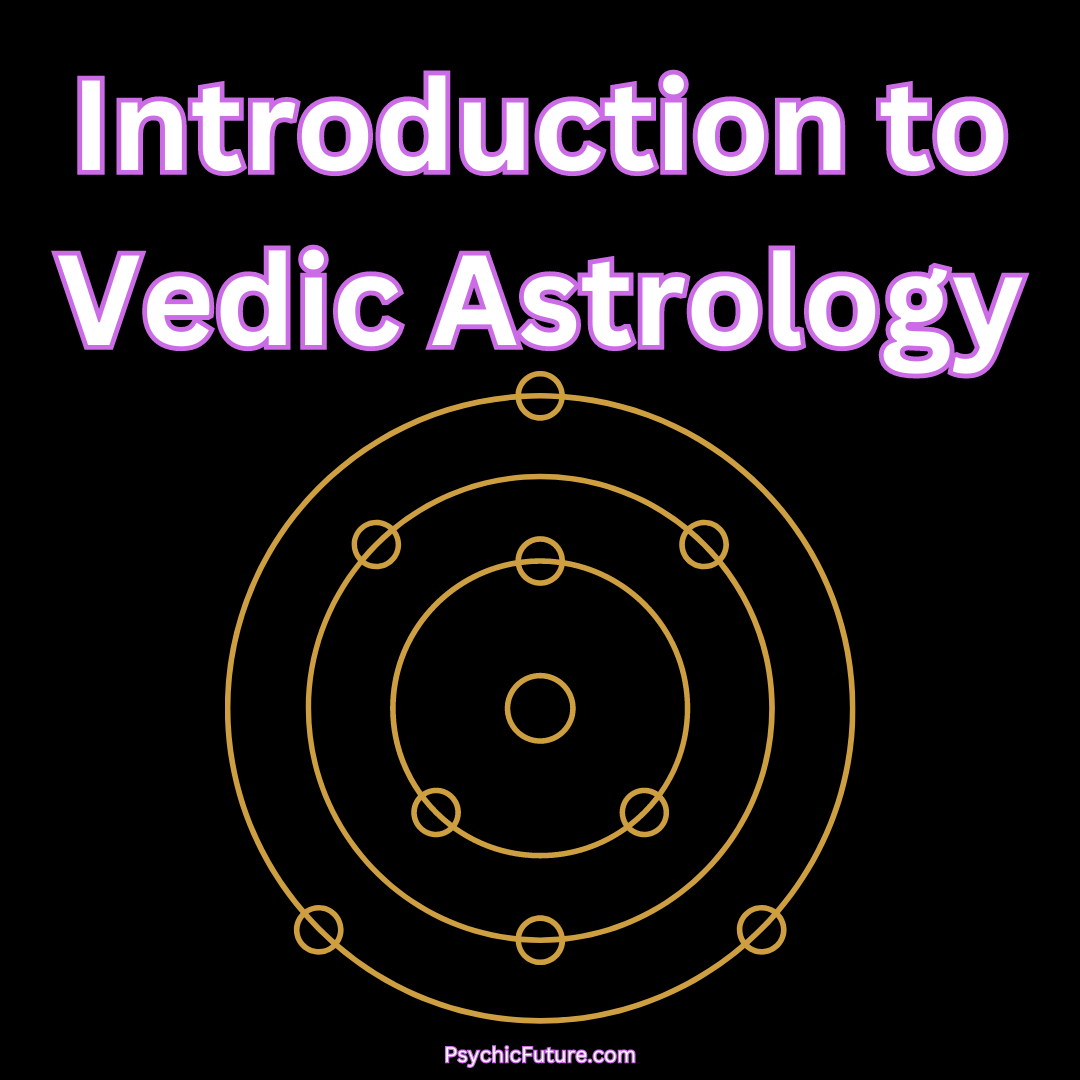 06 Jul 2023
06 Jul 2023
When we gaze at the stars in the night sky, we often marvel at the beauty and vastness of the cosmos. For centuries, these stars have been more than just twinkles of light. They have served as guides and offered insight into the mystery of existence. In this guide, we will delve into Vedic Astrology, an ancient system that seeks to understand the profound connection between the celestial and the terrestrial. Whether you’re a novice or an enthusiast, this guide will unravel the intricacies of Vedic Astrology for you.
Contents
Introduction to Vedic Astrology
“The celestial bodies are the cause of all that takes place in the sublunary world.”
– Ptolemy
Vedic Astrology, also known as Jyotish Shastra, is an ancient Indian science which translates to ‘Science of Light’. It is believed to have originated more than 5,000 years ago in the Vedas, the oldest sacred texts of Hinduism[1].
Vedic Astrology is based on the belief that the positions and movements of celestial bodies have a profound influence on our lives. It helps individuals to understand and optimise their actions according to celestial alignments. Unlike Western Astrology, which is based on the tropical zodiac, Vedic Astrology uses the sidereal zodiac which takes into account the precession of the equinoxes[2].
Key Elements
1. Planets (Grahas)
In Vedic Astrology, there are nine ‘planets’ which are key to understanding a person’s astrological chart. These include the Sun, Moon, Mars, Mercury, Jupiter, Venus, Saturn, and the shadow planets Rahu and Ketu.
2. Zodiac Signs (Rashis)
There are 12 zodiac signs, beginning with Aries (Mesha) and ending with Pisces (Meena). Each sign spans 30 degrees in the celestial sphere.
3. Houses (Bhavas)
The astrological chart is divided into 12 houses, each representing different aspects of life. The first house, for example, represents the self, while the seventh represents relationships.
4. Nakshatras
There are 27 Nakshatras or lunar mansions, which are important for determining the timings of events and compatibility in relationships.
In-depth Understanding
The Birth Chart (Janma Kundali)
A birth chart, or Janma Kundali, is a map of the heavens at the time of your birth. It is the foundation of Vedic Astrology and is used to make predictions and understand an individual’s nature.
Creating a Birth Chart
To create a birth chart, you need to know the date, time, and place of birth. With these details, the positions of the planets in the zodiac signs and houses are calculated. This can be done by an astrologer or through various online tools.
Planets and Their Significance
Each planet represents different aspects of life:
1. Sun (Surya): Soul, power, authority.
2. Moon (Chandra): Mind, emotions, mother.
3. Mars (Mangala): Energy, action, brothers.
4. Mercury (Budha): Communication, intellect, business.
5. Jupiter (Guru): Wisdom, spirituality, children.
6. Venus (Shukra): Love, beauty, wealth.
7. Saturn (Shani): Discipline, sorrow, longevity.
8. Rahu: Materialism, foreign lands.
9. Ketu: Spirituality, detachment.
Zodiac Signs and Characteristics
1. Aries (Mesha): Energetic, confident, impatient.
2. Taurus (Vrishabha): Stable, practical, stubborn.
3. Gemini (Mithuna): Adaptable, communicative, indecisive.
4. Cancer (Karka): Nurturing, intuitive, moody.
5. Leo (Simha): Ambitious, loyal, dominating.
6. Virgo (Kanya): Analytical, meticulous, critical.
7. Libra (Tula): Harmonious, diplomatic, indecisive.
8. Scorpio (Vrishchika): Intense, passionate, secretive.
9. Sagittarius (Dhanu): Adventurous, optimistic, blunt.
10. Capricorn (Makara): Disciplined, cautious, pessimistic.
11. Aquarius (Kumbha): Innovative, social, detached.
12. Pisces (Meena): Compassionate, imaginative, escapists.
The Houses and What They Represent
1. First House: Self, appearance, beginnings.
2. Second House: Wealth, speech, family.
3. Third House: Communication, siblings, short trips.
4. Fourth House: Home, mother, education.
5. Fifth House: Creativity, children, romance.
6. Sixth House: Health, service, enemies.
7. Seventh House: Marriage, partnerships, public dealings.
8. Eighth House: Transformation, death, inheritance.
9. Ninth House: Philosophy, spirituality, long journeys.
10. Tenth House: Career, status, reputation.
11. Eleventh House: Gains, friends, aspirations.
12. Twelfth House: Subconscious, spirituality, losses.
Nakshatras and Their Importance
Nakshatras are subdivisions of the zodiac signs, with each sign containing two or three Nakshatras. They are vital in determining the personality traits, behaviors, and fate of an individual. Each Nakshatra is ruled by a planet and has its own unique attributes.
Tip: When it comes to matchmaking, Nakshatras play a significant role in Vedic Astrology. They are used to assess compatibility between prospective partners.
Dasha System
In Vedic Astrology, the Dasha system is used to predict events and phases in an individual’s life. It is a timeline that indicates the periods during which different planets influence a person’s life.
Vimshottari Dasha
Vimshottari Dasha is the most widely used Dasha system. It is based on the Moon’s position in the Nakshatras at the time of birth. Each planet rules for a specific period, with the total cycle lasting 120 years.
Remedies in Vedic Astrology
Vedic Astrology also offers remedies for mitigating the negative influences of planets. Some of the common remedies include:
1. Mantras: Chanting specific mantras to appease the planets.
2. Gemstones: Wearing gemstones that are associated with beneficial planets.
3. Charity: Donating specific items related to malefic planets.
4. Yantras: Using geometric diagrams for meditation and prayer.
“Astrology is a language. If you understand this language, the sky speaks to you.”
– Dane Rudhyar
Scientific Relevance and Criticism
While many believe in the insights provided by Vedic Astrology, it is crucial to recognise that there is a debate regarding its scientific validity. Critics argue that the predictions made through astrology can be vague and subject to confirmation bias[3]. However, proponents cite personal experiences and traditional wisdom as evidence for its relevance.
The Psychological Aspect
Some psychologists propose that Vedic Astrology can serve as a tool for introspection and self-understanding[4]. The symbolism and archetypes in astrology might reflect inherent psychological traits and patterns.
Ethical Considerations
Astrologers must uphold ethical standards in practice. They should provide guidance responsibly, without instilling fear or exploiting clients. Individuals seeking astrological counsel should approach it with an open mind, but also with critical thinking.
Applications of Vedic Astrology
1. Personal Development
Vedic Astrology can be used to understand one’s innate strengths, weaknesses, and potential life paths. This knowledge can be employed to make more informed decisions and cultivate personal growth.
2. Relationships and Marriage
By examining the compatibility of birth charts, Vedic Astrology can offer insights into the dynamics of relationships. In Indian culture, this is known as Kundali matching, and is a common practice before marriage.
3. Career and Finance
Career prospects and financial fortunes can also be analysed through one’s birth chart. Understanding the planetary influences on these aspects of life can help in planning and decision-making.
4. Health
Vedic Astrology can provide insights into an individual’s health and well-being. However, it’s important to remember that astrology should not replace professional medical advice and treatment.
5. Spiritual Growth
Through self-reflection and understanding of one’s karmic patterns, Vedic Astrology can also serve as a tool for spiritual growth.
A Glimpse into Advanced Topics
1. Divisional Charts (Varga Chakras)
In Vedic Astrology, the birth chart can be divided into multiple divisional charts, each representing different aspects of life. For instance, the Navamsa chart is crucial for analysing marital life.
2. Ashtakavarga System
This is a unique system that calculates the strength of planets and houses to make predictions. It is considered a higher level of analysis in Vedic Astrology.
3. Yogas
Yogas are special combinations of planets in a chart. They can indicate specific fortunes or misfortunes.
Wrapping Up
Vedic Astrology is an ancient wisdom that can provide intriguing insights into various aspects of life. However, it’s important to use this knowledge responsibly and ethically.
“We need not feel ashamed of flirting with the zodiac. The zodiac is well worth flirting with.”
– D.H. Lawrence
Approach Vedic Astrology with an open mind, but also with discernment. Use it as a tool for self-reflection, understanding, and potentially guiding choices, but remember that ultimately, we all have free will and are the architects of our own destinies.
Sources:
[1]: Frawley, D. (2000). Astrology of the Seers: A Guide to Vedic/Hindu Astrology. Lotus Press.
[2]: Sutton, K. (2019). The Scientific Foundation of Vedic Astrology. The American College of Vedic Astrology.
[3]: Carlson, S. (1985). A double-blind test of astrology. Nature, 318(6045), 419-425.
[4]: Greene, L. (2018). The Astrological Neptune and the Quest for Redemption. Weiser Books.
*Disclaimer: This guide is for educational purposes and should not be used as a substitute for professional advice. The field of Vedic Astrology is vast, and this guide provides an introductory overview. It is advised to consult experts for in-depth knowledge and understanding.*
Additional Reading Suggestions:
1. Behari, B. (2003). Fundamentals of Vedic Astrology: Vedic Astrologer’s Handbook Vol. I. Lotus Press.
2. DeFouw, H., & Svoboda, R. (2003). Light on Life: An Introduction to the Astrology of India. Lotus Press.
Final Words of Wisdom:
As you embark on your journey through the intricate realm of Vedic Astrology, remember that, while the stars and planets may guide us, it is our choices and actions that shape our destinies. Embrace the wisdom, but also trust your instincts and make choices that align with your values and aspirations.
“Man is a microcosm, or a little world, because he is an extract from all the stars and planets of the whole firmament.”
– Paracelsus
Happy stargazing!




